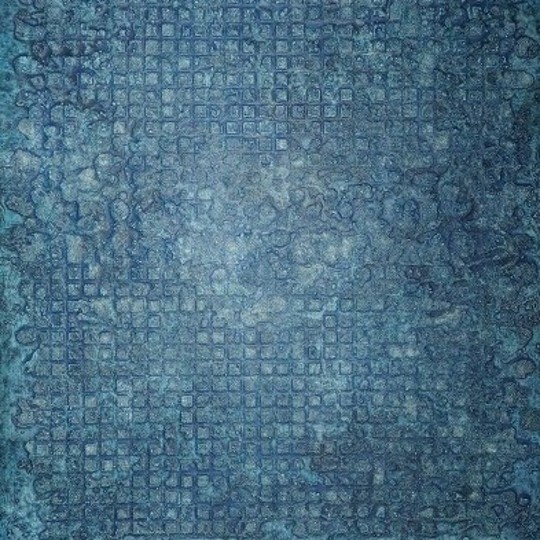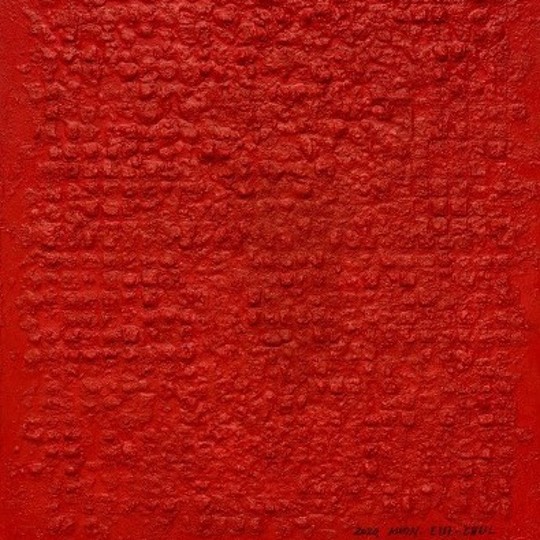김효선
평면성과 반복성
- 1권의철(權義鐵)의 단색화(Dansaekhwa)는 그의 모습만큼이나 맑고 투명하다. 우리는 그 아름다운 화면속으로 이끌려 그의 세계와 마주하게 된다. 그는 비석이나 돌과 같은 다양한 유적 문양과 문자를 작품의 소재 삼아 그의 섬세한 관찰력으로 이를 독대(獨對)하며 비구상적인 단색화로 구현해오고 있는 2세대 단색화 작가이다. 단색화란 우리나라의 경우, 70년대 중반에서 80년대 초반까지 존속했던 회화경향을 말하는데, 이는 넓게 환원적 경향을 가리키지만 실질적으로 화면을 단색으로 물들이면서 평면의 절대성을 유난히 강조한 회화유형을 말한다. 이는 서구의 미니멀리즘과 대비되는데, 이 미니멀리즘은 합리주의적사고의 산물이다. 그러나 한국의 단색화는 정신적인 면이 강조되어, 그 정신세계는 우리 고유의 자연회귀라는 동양의 자연관을 바탕으로 이루어진 미술사조이다. 따라서 권의철의 단색화도 정신성으로 물들어 있다고 할 수 있겠다.
이처럼 우리나라의 단색화는 서구의 미니멀리즘으로부터 그 형식적 영향을 받아 유사하지만, 내용적인면에서 서로 다르다. 서구의 미니멀리즘은 분석적이고 체계적이며 엄격한 조형논리에 근거한 미술 사조였던 반면, 우리나라의 단색화는 직관적이고 선험적이며, 정서적인 면이 강조되어 그 정신세계는 우리 고유의 자연회귀라는 동양의 자연관을 바탕으로 이루어진 미술사조이다. 이러한 동양적인 의식의 흐름이 가장 잘 집약되어 나타나게 된 것이 바로 70년대 후반에서 80년대 초반까지 이어지는 단색화이다. 즉 단색화는 현대회화의 흐름을 거스르지 않으면서도 우리나라의 고유의 정신을 접목한 사조로 우리나라 시각에서 현대 회화를 소화시킨 첫 사조였다는 가치를 지닌다.
권의철의 단색화가 가지는 조형적 특성으로, 우선 “평면성”을 들 수 있다. 그의 회화에서 “평면”의 의미는 캔바스에 어떤 “사물의 일루젼을 구체화시키는 것”으로서가 아니라, 캔바스나 평면적 오브제 등을 이용해 “개념적 수단”으로서 보여주고자 하는 평면을 가리킨다. 모더니즘의 가장 큰 특징은 전통적인 시각 예술의 인습 부정, 회화의 일루젼으로부터의 탈피와 추상화이다. 권의철의 단색화에서 회화의 “평면성”의 문제는 모더니즘의 이러한 일련의 자기 규정, 자기 환원이라는 속성과 관련된 것이다.
권의철의 단색화가 가지는 두 번째 조형적 특징은 “반복성”이다. 그는 원형질과 같은 어떤 형상을 캔바스 위에반복하여 나열하고 있는데, 이는 화면을 전면구도(all-over)로 이끌고 있다. 순수회화에서 이러한 반복의 방법이 적극적으로 수용된 것은 20세기에 이르러서이다. 권의철의 신체의 반복적 행위를 통해 그는 명상의 경지에 접근한다. 이는 물질과 행위의 상호작용에 의한 물질의 비물질화를 보여주는 예라고 할 수 있다. 여기서 물질과 비물질의 세계의 경계는 없어진다. 다시 말하면 대상과 정신의 합일, 즉 주객의 합일이 이루어지고 물질화되는 정신은 하나의 통합된 세계, 범자연주의 세계를 상징하게 된다. 이것이 외형적으로 서구의 미니멀리즘과 흡사하면서 다른 점이라고 할 수 있다.
이처럼 우리 고유의 독자적 세계를 추구하는 권의철의 단색화는 맑고 투명한 자신만의 정신세계를 추구하기에 더욱 의미가 깊다. 권의철은 우리나라 단색화의 2세대 작가로서 그 맥을 이어가는 이 시대의 후진이라 할 수 있다.
따라서 화단(畫壇)에서 그의 역할과 위상은 높다 하겠다. 이제 그가 인도하는 저 피안(彼岸)의 세계로 함께 떠나보자, 그리고 그곳에서 마음의 평정(平靜)과 평화(平和)를 얻어보자.
김 효 선 독립큐레이터/
이화여자대학교 대학원 미술사학과
權義鐵의 단색화( Dansaekhwa)
flatness & repeatability -the thought about time and space -
Hyoseon Kim (Independent Curator)
1) flatness & repeatability
- 1The Dansaekhwa of Eui-chul Kwon is clean and transparent as his appearance. And we face his beautiful painting. He is the 2nd generation of Dansaekhwa artist, he makes his painting with print and letter of remains ston. Dansaekhwa is the tendency of Korea, from 70’s to early 80’s. It emphasizes the flatness of canvas.
So we can compare it with western minimalism, but minimalism is the products of rationalism, and Dansaekhwa is the products of spiritualism. It is based on the oriental view of nature, to return to the nature. So the Dansaekhwa of Euichul Kwon also is dyed by sooirituality. As it, the Korean Dansaekhwa is similar to the western minimalism by influence of form, but the substance is different each other.
- 1The western minimalism is analytic and systematic, but Korean Dansaekhwa is intuitiveand transcendental, so it’s spiritual world is based on the oriental view of nature, to return to the nature. It is Dansaekhwa from late 70’s to early 80’s that the stream of oriental conciousness is appeared well. So Dansaekhwa is the first tendency not to go back and to connect with Korean traditional esprit. The first character of Kwon’s painting is the “flatness”. In his painting, the meaning of “flatness’ is not ”to actualize of thing’a illusion“, but ”to show the conceptual method“. The first character of modernism
is the denial about the traditional art, the escape of the illusion of painting and abstraction. In Kwon’s Dansaekhwa, the painting
”flatness“ is about the self regulation, and self reduction of modernism.The second character of Kown’s painting is the “repeatability”. Hearranges the certain shape of a canvas repeatedly, it leads the canvas
to all-over composition. It is 20th century that accept the repeatability method in the pure painting. He approaches to the stage of meditation by repetitive action of his body. It is the example to show
the non-materialization of material by the interaction of material and action. Here, he border beween material and non-material removed. Namely the unity of object and subject is emblematic of the untied world. It is the similarity and deference with minimalism.
- 1Kwon’s Dansaekhwa is meaningful because he seek the clean and transparent spiritual world. He is the junior, 2nd generation artist to follow the first generation of Dansaekhwa. So in the world of art,
his role and state is so high. Now let’s leave to the far-beyondworld to be led by him. And let’s gain the calmness and peace of mind at there by him.
2) the thought about time and space
- 1The theory concerns with environment to bear it. Like it art also expresses environment, the philosophy of time visually. The existentialism has motto “here and now”. It is about time and space. Namely the existentialism is the art tendency to birth from the philosophical environment. He also show us the painting to restricted by time and space. In his painting time show the trace of thought and contains the memory of past. And in his painting space can not escape the frame of canvas. But it becomes the area of his thought and experience.
In the memory of dictionary, this is the present concept to mean this instance right now. Past is the previous, and future is the coming from now on. The front of flowing not to win art, time is the development of desire ot make forever it and reverse it. The title of Euichul Kown, “the trace of time” is because of the flow of making progress to cover canvas with color. It is the making by the view point of linear time intervening of physical behavior. The view point of linear is from the historical view point of development. Also A. Einstein persists the simultaneity of time, It stretches out at same time without border. Euichul Kwon also show the painting by the concept of Bergson’s continuity. The concept of Bergson’s continuity is expressed with the consecutive image, it is repetitive and consective of one image compare with Kown’s painting.
- 1In the meaning of dictionary, space is the three-dimensional span, and in the meaning of philosophy. it is the basic form to make the world with time. Even though the independent thing, it is possible to stand without near space. The thought aobut space is possible to consist of the various system. Kwon’s conscious space to pass through the organization process and the special thought and experience, becomes potential space to discover self. So Kwon’s conscious space supply us “his space” to think. At that time potentiality includes much more things and exist inner the real. And it becomes the essential thought to support the extension about space. This thought has the positive power to make the difference inner it. In his painting, the consciousness about fluent space and the regrettable attitude about the physical canvas bears the result to make “the space of him” giving the movement to empty space.
Euichul Kwon paints the canvas with several layered color. It is the area of creation to contain new experience of him and his memory. It is also the area of behavior, and the expression of ideal material. He expresses the trace of time to become forget painting color on his canvas. And it deliver us the meaning of esprit. Past always changes by the new presence. His painting, the Korean 2th generation of Dansaekhwa, delivers us the thought about existence.




